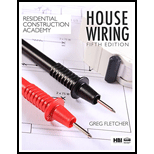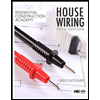
Residential Construction Academy: House Wiring (MindTap Course List)
5th Edition
ISBN: 9781337402415
Author: Gregory W Fletcher
Publisher: Cengage Learning
expand_more
expand_more
format_list_bulleted
Concept explainers
Question
Chapter 3, Problem 1RQ
To determine
The correct match of the given hand tools to their common residential electrical trade use.
Expert Solution & Answer
Explanation of Solution
The following table shows the correct match of the given hand tools to their common residential electrical trade use:
| Hand tools | Use |
| 1. Lineman pliers | b. Used to cut cables and conductors, form large conductors, and pull and hold conductors |
| 2. Adjustable wrench | a. Used to remove and install slot-head screws and to tighten and loosen slot-head pressure connectors |
| 3. Wire strippers | e. Used to strip insulation from conductors |
| 4. Electrician’s Knife | g. Used to strip large conductors and cables |
| 5. Philips Screwdriver | j. Used to drive and pull nails, pry boxes loose, and strike chisels |
| 7. Triple-tap tool | h. Used to tap 6-32, 8-32, and 10-32 holes for securing equipment to metal, re-tap damaged threads, and determine screw sizes. |
| 8. Long-nose pliers | c. Used to form small conductors, cut conductors, and to hold and pull conductors |
| 9. Multipurpose tool | f. Used to strip insulation, crimp solder-less connectors, cut and size conductors, and cut and thread small bolts |
| 11. Awl | i. Used to start screw holes, make pilot holes for drilling, and mark metal |
| 12. Diagonal pliers | d. Used to cut cables and conductors in a limited space |
Want to see more full solutions like this?
Subscribe now to access step-by-step solutions to millions of textbook problems written by subject matter experts!
Students have asked these similar questions
10. A short column is subjected to an eccentric loading. The axial load P =
1000 kips and the eccentricity e = 12 in. The material strengths are fy = 60 ksi
and f = 6000 psi. The Young's modulus of steel is 29000 ksi.
(a) Fill in the blanks in the interaction diagram shown below.
(2pts each, 10pt total)
Po
Pn
(1)
failure range
H
3"
30"
Ast 6 No. 10 bars
=
P
22"
I
e
H
3"
(4) e =
e small
Load
path for
given e
Radial lines show constant (2)
eb
(3)
e large
failure range
Mn
(5) e=
Mo
(b) Compute the balanced failure point, i.e., P and Mb.
No chatgpt pls
11. The prestressed T beam shown below is pretensioned using low relaxation
stress-relieved Grade 270 strands. The steel area Aps = 2.5 in². The tensile
strength is fpu = 270 ksi, and the concrete compressive strength is fr =
6000 psi.
(a) Calculate the nominal moment strength Mn with hr = 6 in.
22"
15"
T
hf
(b) Since this beam is a T-beam, the nominal moment strength M₁ increases with a thicker hf. However, M, stops
increasing if he reaches a value. Determine the minimum thickness hy that can achieve the maximum nominal moment
strength Mr. Also, calculate the corresponding maximum nominal moment strength Mn with the computed hf.
Chapter 3 Solutions
Residential Construction Academy: House Wiring (MindTap Course List)
Knowledge Booster
Learn more about
Need a deep-dive on the concept behind this application? Look no further. Learn more about this topic, civil-engineering and related others by exploring similar questions and additional content below.Similar questions
- 10. A short column is subjected to an eccentric loading. The axial load P = 1000 kips and the eccentricity e = 12 in. The material strengths are fy = 60 ksi and f = 6000 psi. The Young's modulus of steel is 29000 ksi. (a) Fill in the blanks in the interaction diagram shown below. 30" Ast 6 No. 10 bars = Pn (1) Po (4) e = e small Load path for given e failure range Radial lines show constant (2) eb (3) e large failure range Mn (5) e= Mo (b) Compute the balanced failure point, i.e., P and Mb. H 3" P 22" I e H 3"arrow_forward10. A short column is subjected to an eccentric loading. The axial load P = 1000 kips and the eccentricity e = 12 in. The material strengths are fy = 60 ksi and f = 6000 psi. The Young's modulus of steel is 29000 ksi. (a) Fill in the blanks in the interaction diagram shown below. 30" Ast 6 No. 10 bars = Pn (1) Po (4) e = e small Load path for given e failure range Radial lines show constant (2) eb (3) e large failure range Mn (5) e= Mo (b) Compute the balanced failure point, i.e., P and Mb. H 3" P 22" I e H 3"arrow_forward7. Match the given strand profiles with the corresponding loading conditions for a prestressed concrete (PSC) beam. Strand profile (b) (d) (c) (a) Ꮎ Load on a beamarrow_forward
- 4. For serviceability considerations, the effective moment of inertia (Ie) is calculated using the following formula: le 1 - 1cr ((2/3) Mcr) Ma 2 - وا ≥ Note that the upper bound was previously set as Iut in the earlier ACI equation. (a) Arrange the following moment of inertia values in ascending order (from smallest to largest): le, Ier, Ig and lut (b) Mer is the cracking moment. Choose the cross-section that should be used to compute Mcr. NA. h 5. Identify and circle the figure that represents the scenario in which the torsional effect is permitted to be reduced according to the ACI code provisions. (3 pts) mt mi B (b)arrow_forwardI will rate, thanksarrow_forward. 9. A reinforced concrete beam is subjected to V/ = 40 kips and Tu/ = 12 ft kips at the critical section. Given conditions: ⚫ Longitudinal reinforcements use No. 8 grade 60 steel with an effective depth d = 20 in. For shear capacity, V = 18 kips and V₂ = 22 kips • For transverse reinforcements, use No. 3 bars with grade 60. • The effective torsional area of A. = 150 in². • Crack angle = 45° ⚫ The minimum stirrup spacing is Smin = 4" and the maximum stirrup spacing is Smax = Find the required stirrup spacing at the critical section. 8".arrow_forward
- 3. The beam shown on the right uses three No. 8 bars made of Grade 60 steel as longitudinal reinforcement. The allowable maximum center-to-center spacing of the longitudinal rebars has been determined to be 10 inches. Now assume that Grade 80 steel will be used instead. Determine whether the beam satisfies the rebar spacing requirements according to the ACI Code. Additional assumptions: • Estimate fs = fy • 20" Clear cover: ? 12" Clear side cover: 1.5" The clear cover depth cc and the clear side cover remain unchanged, regardless of the change in material.arrow_forward6. For the slender columns shown below: a) Determine the effective buckling length factor (k) for each column. b) Circle the column with the largest buckling capacity, assuming all columns have the same length (f) and the same flexural rigidity (E+I) k = (a) (b) (c) (d)arrow_forward5. Identify and circle the figure that represents the scenario in which the torsional effect is permitted to be reduced according to the ACI code provisions. mi (a) V7+ B (b)arrow_forward
- 5. Identify and circle the figure that represents the scenario in which the torsional effect is permitted to be reduced according to the ACI code provisions. (3 pts) mi (a) V7+ B (b)arrow_forwardIf you can briefly answer each of the given questions I will rate, thanks.arrow_forwardhandwritten solution only. pls provide instructionsarrow_forward
arrow_back_ios
SEE MORE QUESTIONS
arrow_forward_ios
Recommended textbooks for you
 Residential Construction Academy: House Wiring (M...Civil EngineeringISBN:9781337402415Author:Gregory W FletcherPublisher:Cengage Learning
Residential Construction Academy: House Wiring (M...Civil EngineeringISBN:9781337402415Author:Gregory W FletcherPublisher:Cengage Learning Residential Construction Academy: House Wiring (M...Civil EngineeringISBN:9781285852225Author:Gregory W FletcherPublisher:Cengage Learning
Residential Construction Academy: House Wiring (M...Civil EngineeringISBN:9781285852225Author:Gregory W FletcherPublisher:Cengage Learning

Residential Construction Academy: House Wiring (M...
Civil Engineering
ISBN:9781337402415
Author:Gregory W Fletcher
Publisher:Cengage Learning

Residential Construction Academy: House Wiring (M...
Civil Engineering
ISBN:9781285852225
Author:Gregory W Fletcher
Publisher:Cengage Learning